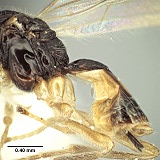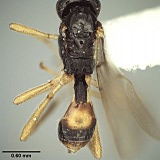Eurytenes was originally described by
Foerster (1862) to accommodate
Opius abnormis Wesmael, 1835, a species with distinctive wing venation. Despite numerous changes in opiine classification since
Foerster (1862),
Eurytenes has almost universally been treated as a valid genus (see
Quicke et al. 1997 for an exception).
Wharton (1988) broadened the concept of
Eurytenes by including
Opius macrocerus Thomson, 1895, and
Fischer (1998) expanded the concept further, proposing six subgenera (
Eurytenes s. s.,
Jucundopius Fischer, 1984;
Stigmatopoea Fischer, 1986;
Xynobiotenes Fischer, 1998;
Oetzalotenes Fischer, 1998;
Opiotenes Fischer, 1998).
Fischer (1998) included 16 species, and 11 others have been added through 2012 (
Chen and Weng 2005,
Wu and Chen 2006,
Walker and Wharton 2011,
Wharton et al. 2012).
Van Achterberg (2004) recognized
Xynobius Foerster, 1862 as a valid genus and transferred
Stigmatopoea to it but did not discuss
Eurytenes.
Wharton (2006) placed
Xynobius as a subgenus of
Eurytenes.
Eurytenes s. s. is defined by the attachment of the radial cross-vein® to the extreme base of the stigma. In the remaining subgenera of
Eurytenes s. l. (
Xynobius,
Jucundopius,
Stigmatopoea,
Xynobiotenes,
Oetzalotenes, and
Opiotenes), r arises more distally along the stigma.
Wharton (1988, 2006), Fischer (1998), and Wu and Chen (2006) provide diagnoses for Eurytenes s. s. and s. l.



